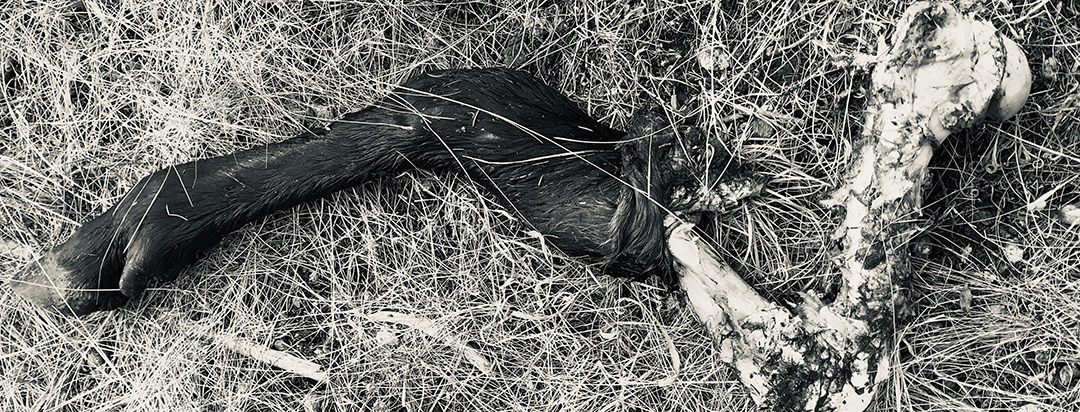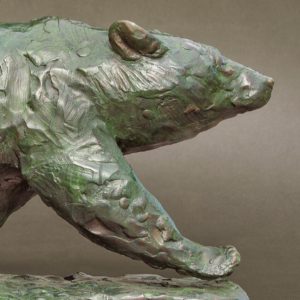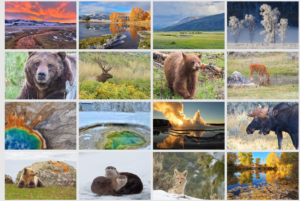The dismembered leg is fresh. Extremely fresh. Laying on a faint animal trail amid cured grasses and the first fallen leaves of autumn, it didn’t simply fall off; it was chewed off. The limb has been worried by carnivorous teeth, stripped of its flesh and dropped here like a bag of McDonald’s trash pitched from the window of a rusted-out pickup on a back road to nowhere. It’s a huge red flag telling us there’s an elk carcass somewhere nearby: something you don’t really want to run into when hiking in grizzly country.
In spite of the seeming gruesomeness, I find the leg oddly beautiful. Its architecture is a monument to time and the wonders of functional evolution. Dark, sheer fur still hugs the supple skin of the metatarsal bone like lycra; although it is devoid of life, the leg still ripples with vitality.
“It’s a front leg,” I think to myself, “probably the right,” even though the giveaway shoulder blade and the remaining quarter-ton of animal is missing. A voice outside my head chimes in, it’s Jenny.
“Do you think somebody just dropped it here?”
I answer in my head expecting that she’ll hear me, but of course she doesn’t (she loves when I do this, not), and I quickly follow with a low, “ohhh… yeah”. My mind is bounding ahead to the key question of the day, “where the hell is the rest of this pungent, bear-claimed, raven-swarmed, coyote-scavenged slab of elk?” I close my eyes, take a couple deep breaths.
“Where is it,” I ask? I play these games with myself at times—a version of “Where’s exactly is dead Waldo” in this 2.2 million acre wilderness? Intuition can sometimes fill in the void where empirical evidence is nil. The more our senses are engaged, the greater the odds that they will ensnare things that we aren’t always conscious of; akin to a trawler scooping up every scallop, discarded boot, trashed crab pot or mammoth tusk in its path. The mental ocean runs deep and quietly churns through endless permutations of data encoded in nuance: the flick of a magpie’s silent wing, the amount of humidity in the air, a directional ‘lay’ of nearby grasses, shifts in the prevailing breeze, or the eerie lack of bird calls in one direction or another. These cognitive gymnastics can yield insights that the thinking mind misses. The fruits of these labors come as feelings, hunches, intuitive inclinations that can steer us in one direction or another. Needless to say our senses are on high alert to avoid stumbling on what is obviously a very fresh carcass.
“There it is,” says Jenny mere moments later. Not a hundred yards from the leg is a fine young spike bull elk, or what’s left of him—laying outstretched on his left side in a watery grave, the plush brown velvet still sheaths his spindly antlers. He came to rest in the bottom of a timbered draw along a small spring seep: and in the deafening quiet, we can hear it trickling.
Then the smell hits us. Unlike putrid, oozing carrion that might bring you to involuntarily, open-mouthed dry heaves or coax up a teaspoon of your latest meal, this odor is different; acrid, almost spicy, haunting.
With hands on bear sprays, we survey every inch of the forest understory from the hill above the carcass. Each log, every patch of brush, every shady tree buttress is scoured for signs of large, clawed and toothy things. We take a QUICK look from above through binoculars, before charting a path right the hell out of there.
Jenny has a knack for picking out things like this. She just finds stuff; she’s the real eyes of this operation. It never fails when there is something monumentally interesting hidden in plain view, Jenny will pinpoint it. Whether it is the 18th summer tanager ever seen in Montana, a shy mangrove cuckoo flitting about its namesake tree in the Florida Everglades, the cougar slipping away from its kill against a tapestry of snow and spruce, or the neon orange bear shit that I just walked right past along the trail, she’ll spot it. We oft joke that she’s “the spotter” and I’m the “IDer”. We’re a good team that way.
“I don’t always know what it is,” she’ll say, “but I know it’s different”. I fill in the role of walking field guide and interpreter of all things animal behavior—then we might turn and smile at each other and give thanks for yet another reason we found each other all those years ago. It’s still debatable though as to who spotted who first…
In our momentary survey of the scene, we find that the elk’s face is a messy void of missing hide and tissue transitioning into shattered nasal and premaxillary bones. The skin of his neck is peeled back and slightly down his neck like a frayed tube sock slumped down upon a preteen’s boney ankle. Broken ribs with ripped hide and entrails leave a disquieting hole from the front of his right pelvis up past where that missing right front leg used to be.
And then we both notice something unusual, two organs lying outside of his body, one beside the other, a foot or two from the carcass. From a distance, it appears that one of them is part of a lung, pink and spongy-looking, the other is what looks like a lobe of the the liver—flat, dense and drying-blood black. These are the most digestible, highest protein cuts and despite making most modern Homo sapiens stomachs churn, the organ meats are usually the first to go. The fact that they are out and exposed like this makes me wonder if we’ve interrupted someone’s meal. We keep our heads on a swivel.
What is this elk’s story, where did he come from, where was he born, where was he going, what did he encounter during his short life, how did he really meet his end? The main road is not far above us; the frequent hiss of tires on pavement act as a reminder. Was he road-killed? Did the headlights veer before he was slammed to the asphalt, breaking his nose and piercing his lung with splintered bone? Did he feel the pain or just clamor to his feet, mortally wounded, only to be washed down the hill on a gush of adrenaline? Did he die on his feet or lay in a broken pile for hours, eyes dilated, breathing in agony, mouth wide open?
These are terrible scenarios to image and just pondering them brings back the vivid details of a lifetime of living with death. So often when we might find a skull, a random bone, or a hoof on a hike, we can’t help longing for the story. The imagination runs wild. And per usual, we will never know.
Spend enough time outside and you too will find these things—whether you want to or not. Life happens, death happens and one could just as easily walk upon a mother deer giving birth as you could that same mother half buried in dirt and laid upon by a grizzly bear staring you square in the eyes, gaze fixed, jaws snapping open and closed, teeth popping.
Encounters are these, and the one in Stumbling Upon A Grizzly Bear Banquet are clear reminders of the hazards of hiking in grizzly country.
Disclaimer: NEVER go seeking carcasses on purpose and furthermore, if you want to take a peek, don’t bother them until every bird and mammal scavenger is gone—usually a period of several days to a week plus. Not only is scaring the hunters and scavengers off against the rules in the park, it is unethical—and dangerous to your health. This is why when we chance upon one of pure dumb luck (i.e. when the wind is blowing the wrong way to carry the scent to us, no bird activity or other indicators give it away until we are too close), we don’t linger, even if the coast is clear. If you can view it from a distant hill top or roadside vantage point, fine, but other than that, don’t press your luck. Also, make sure you know how to hike safely in grizzly country.



